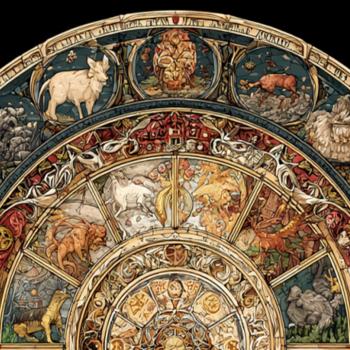
These thinkers were tapping into something that goes far beyond an internet connection; they were mapping out the timeless realms of the mind and spirit, describing patterns of collective thought, transcendent love, and mindful presence long before the internet came along.
So what happens when we apply their ideas to the Noomasphere?
Let’s dive into how these giants of wisdom might help us see this space as something more than just data.
Carl Jung: The Noomasphere as a Collective Unconscious
Carl Jung was fascinated by what he called the collective unconscious—a realm of universal archetypes, symbols, and experiences shared by all humans. He saw this shared reservoir of ideas as a fundamental part of our psychology, influencing our dreams, fears, and relationships.
In many ways, the Noomasphere is a digital expression of Jung’s concept. It’s a space where archetypes, symbols, and universal themes—whether of love, courage, or fear—are constantly circulated and reshaped.
Every meme, viral video, or philosophical post we encounter taps into these timeless symbols, triggering responses from deep within our shared psyche.
Through the Noomasphere, we’re not just interacting with each other; we’re interacting with the collective unconscious. It’s a place where our deepest desires, insecurities, and spiritual longings find expression and validation.
Jung would remind us to pay attention to the symbols that emerge online, recognizing them as clues to our own inner worlds and guides in our journey toward individuation, or self-realization.
Alan Watts: Finding the Cosmic Dance in the Noomasphere
Then we have Alan Watts, the spiritual entertainer who brought Eastern philosophy to the West, reminding us that we are not separate from the universe but deeply woven into its fabric.
Watts might look at the Noomasphere as a digital “cosmic dance,” a place where ideas flow freely, collide, and merge into something new. In his words, “you are an aperture through which the universe is looking at and exploring itself.”
So, in the Noomasphere, we’re not just connecting to each other; we’re connecting to the universe experiencing itself through countless individual viewpoints.
Watts would likely revel in the beauty of this chaotic idea-sharing ecosystem, seeing it as an extension of the interconnectedness he championed. Every like, comment, and post is part of this cosmic dance, a reminder that all our experiences are intertwined.
If we can embrace this perspective, then the Noomasphere becomes a reminder that we’re all participants in something much bigger than ourselves—a digital expression of cosmic unity.
Rumi: Love and Union in the Digital Sphere
Ah, Rumi, the Sufi mystic and poet who wrote about the unity of all beings and the divine love that transcends time, place, and form.
For Rumi, the idea of love was boundless; it was the very essence of life itself. And isn’t that what the Noomasphere can be at its best—a space for connecting and finding unity in diversity?
In the digital world, we see strangers supporting each other, sharing their most vulnerable stories, and connecting across oceans.
Rumi’s poetry about union and the heart’s deep longing for connection speaks directly to the spirit of the Noomasphere. He would see the internet as another way for souls to connect beyond the physical, finding glimpses of the Beloved in each other’s words and ideas.
Rumi teaches us to approach this space with love and openness, allowing the Noomasphere to be a place of spiritual communion, where the love that binds all things is honored and celebrated.
Thich Nhat Hanh: Mindfulness in the Age of the Noomasphere
Thich Nhat Hanh, the Zen Buddhist monk and teacher of “mindfulness,” would probably caution us to approach the Noomasphere with presence and intention. For him, mindfulness is the act of being fully present in each moment, aware of the impact of our thoughts, words, and actions.
The Noomasphere, with its endless scroll and countless opinions, can easily draw us away from this mindfulness. But, if we follow Thich Nhat Hanh’s teachings, we can use it as a practice ground—a space to be mindful and compassionate in every interaction.
He might remind us that every post, comment, and click is a chance to practice “engaged mindfulness.” We can choose to respond thoughtfully, to spread kindness rather than negativity, and to create space for others to feel seen and understood.
Thich Nhat Hanh would encourage us to use the Noomasphere as an opportunity for spiritual growth, to breathe between each interaction, and to remember that behind every screen is a real, living person.
Weaving It All Together
When we look at the Noomasphere through the wisdom of Jung, Watts, Rumi, and Thich Nhat Hanh, it transforms from a simple collection of online interactions into a spiritual landscape.
Jung gives us insight into its archetypal power; Watts reminds us of our interconnectedness; Rumi speaks to the love that flows through it; and Thich Nhat Hanh teaches us to engage with mindfulness.
Together, they offer a roadmap for seeing the Noomasphere as a space of true transformation, a digital mirror reflecting the depths of our own souls and our collective evolution.
So, next time you log on, bring a bit of Jung’s curiosity, Watts’ cosmic wonder, Rumi’s love, and Thich Nhat Hanh’s mindfulness with you.
See the Noomasphere not just as a space of fleeting content but as a spiritual practice, a place where we come together to learn, grow, and evolve.
In the Noomasphere, we’re not just interacting with information; we’re encountering reflections of our own souls and, perhaps, inching closer to the divine.
**

The newest book from Keith Giles, “The Quantum Sayings of Jesus: Decoding the Lost Gospel of Thomas” is available now on Amazon. Order HERE>
Keith Giles is the best-selling author of the Jesus Un series. He has appeared on CNN, USA Today, BuzzFeed, and John Fugelsang’s “Tell Me Everything.”
He co-hosts The Heretic Happy Hour Podcast and his solo podcast, Second Cup With Keith which are both available on Spotify, Amazon, Apple, Podbean or wherever you find your podcast fix.













